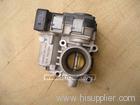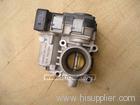|
K.G. (HK) Co., Ltd.
|
throttle body
| Place of Origin: | Zhejiang, China (Mainland) |
|
|
|
| Add to My Favorites | |
| HiSupplier Escrow |
Product Detail
throttle body
In fuel injected engines, the throttle body is the part of the air intake system that controls the amount of air flowing into the engine, in response to driver accelerator pedal input in the main. The throttle body is usually located between the air filter box and the intake manifold, and it is usually attached to, or near, the mass airflow sensor.
The largest piece inside the throttle body is the throttle plate, which is a butterfly valve that regulates the airflow.
On many cars, the accelerator pedal motion is communicated via the throttle cable, to activate the throttle linkages, which move the throttle plate. In cars with electronic throttle control (also known as "drive-by-wire"), an electric motor controls the throttle linkages and the accelerator pedal connects not to the throttle body, but to a sensor, which sends the pedal position to the Engine Control Unit (ECU). The ECU determines the throttle opening based on accelerator pedal position and inputs from other engine sensors.
Throttle body showing throttle position sensor. The throttle cable attaches to the curved, black portion on the left. The copper-coloured coil visible next to this returns the throttle to its idle position when the pedal is released.
When the driver presses on the accelerator pedal, the throttle plate rotates within the throttle body, opening the throttle passage to allow more air into the intake manifold. Usually an airflow sensor measures this change and communicates with the ECU. The ECU then increases the amount of fuel being sent to the fuel injectors in order to obtain the desired air-fuel ratio. Often a throttle position sensor (TPS) is connected to the shaft of the throttle plate to provide the ECU with information on whether the throttle is in the idle position, wide-open throttle (WOT) position, or somewhere in between these extremes.
Throttle bodies may also contain valves and adjustments to control the minimum airflow during idle. Even in those units that are not "drive-by-wire" there will often be a small electric motor driven valve, the Idle Air Control Valve (IACV), that the ECU uses to control the amount of air that can bypass the main throttle opening.
Image of BMW S65 from the e92 BMW M3 showing eight individual throttle bodies
Many cars have a single throttle body, however more than one may be used, chained together by linkages, to improve throttle response. At the extreme, high performance cars, such as the BMW M1, and high performance motorcycles, like the Suzuki Hayabusa, have a separate throttle body for each cylinder. These are often referred to as "individual throttle bodies", or ITBs.
A throttle body is somewhat analogous to the carburetor in a non-injected engine. Carburetors combine the functionality of the throttle body and the fuel injectors into one, that is, to modulate the amount of air flow, and to combine air and fuel together. Cars with throttle body injection (called TBI by General Motors and CFI by Ford) locate the fuel injectors in the throttle body, thereby allowing an older engine to be converted from carburetor to fuel injection without significantly altering the engine design.
Related Search
Throttle
Throttle Cable
Throttle Valve
Throttle Position Sensor
Solenoid Throttle Valve
Electric Motor Throttle
More>>



